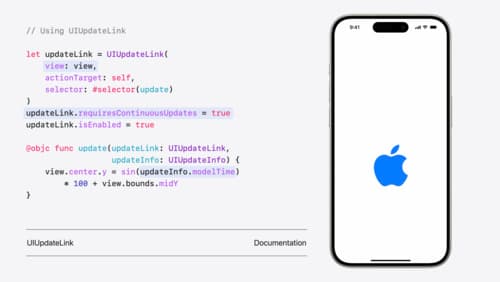Uiview.animate
Asked on 2024-08-12
1 search
The UIView.animate method has been enhanced to work seamlessly with SwiftUI animations, allowing for synchronized animations across UIKit and SwiftUI components. This is particularly useful when you have a UIKit component embedded in a SwiftUI app, or vice versa, and you want to ensure that animations run smoothly and in sync.
In the session titled "Enhance your UI animations and transitions," it is explained how the new animate method on the context allows you to apply any animation on the transaction associated with an update to any UIView changes. This ensures that animations run perfectly in sync, even across framework boundaries. The session also covers how to handle animations in response to both discrete actions and continuous gestures, leveraging SwiftUI's ability to preserve velocity at the end of a gesture.
For more details, you can refer to the session Enhance your UI animations and transitions (10:23).

What’s new in UIKit
Explore everything new in UIKit, including tab and document launch experiences, transitions, and text and input changes. We’ll also discuss better-than-ever interoperability between UIKit and SwiftUI animations and gestures, as well as general improvements throughout UIKit.

Enhance your UI animations and transitions
Explore how to adopt the zoom transition in navigation and presentations to increase the sense of continuity in your app, and learn how to animate UIKit views with SwiftUI animations to make it easier to build animations that feel continuous.

What’s new in SwiftUI
Learn how you can use SwiftUI to build great apps for any Apple platform. Explore a fresh new look and feel for tabs and documents on iPadOS. Improve your window management with new windowing APIs, and gain more control over immersive spaces and volumes in your visionOS apps. We’ll also take you through other exciting refinements that help you make expressive charts, customize and layout text, and so much more.
